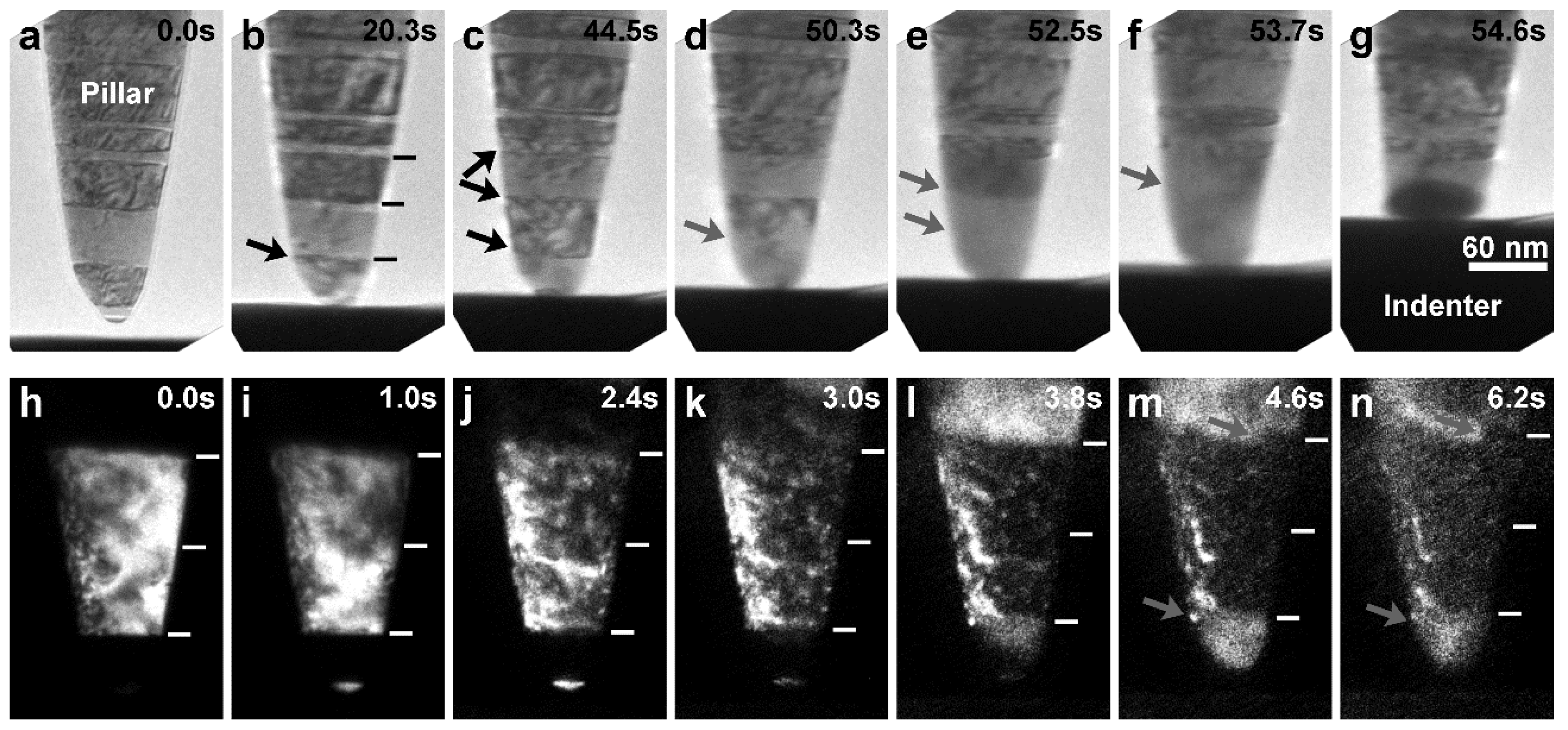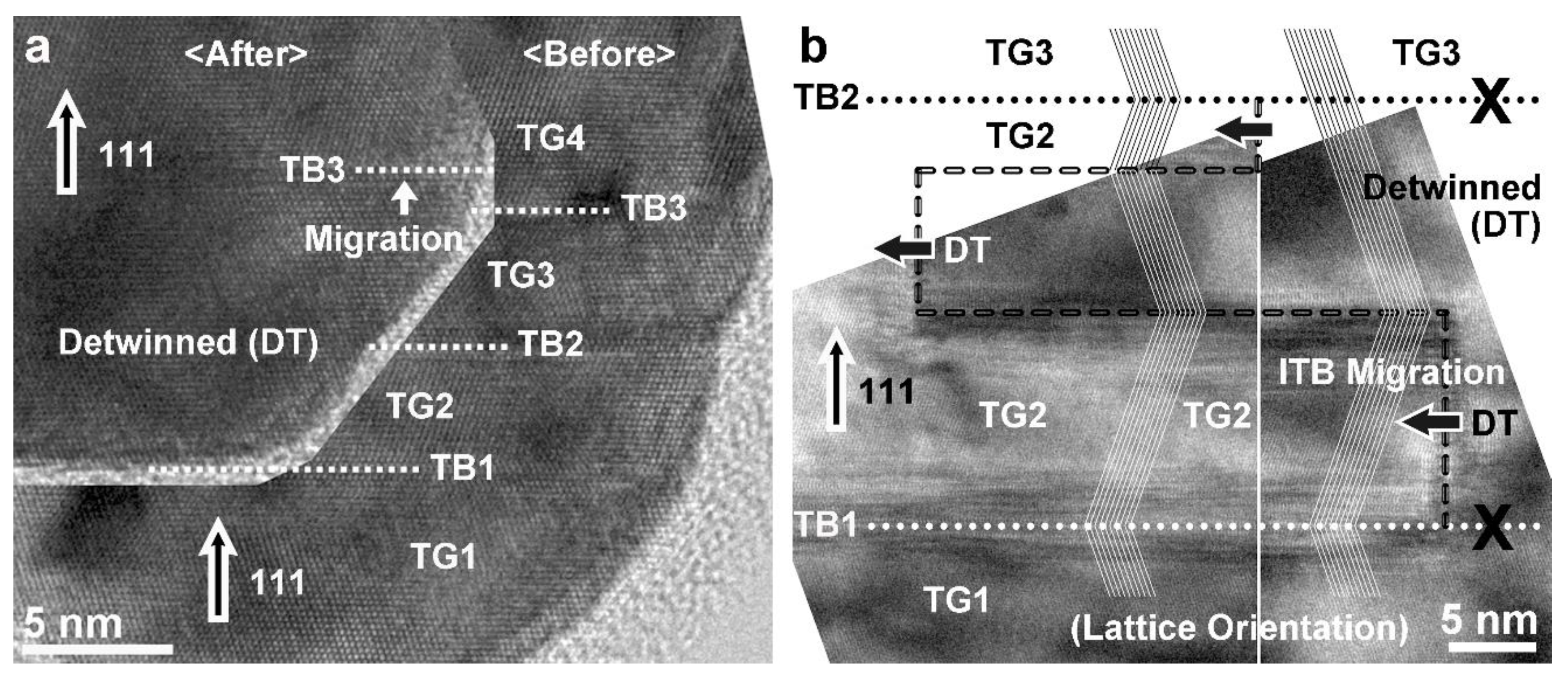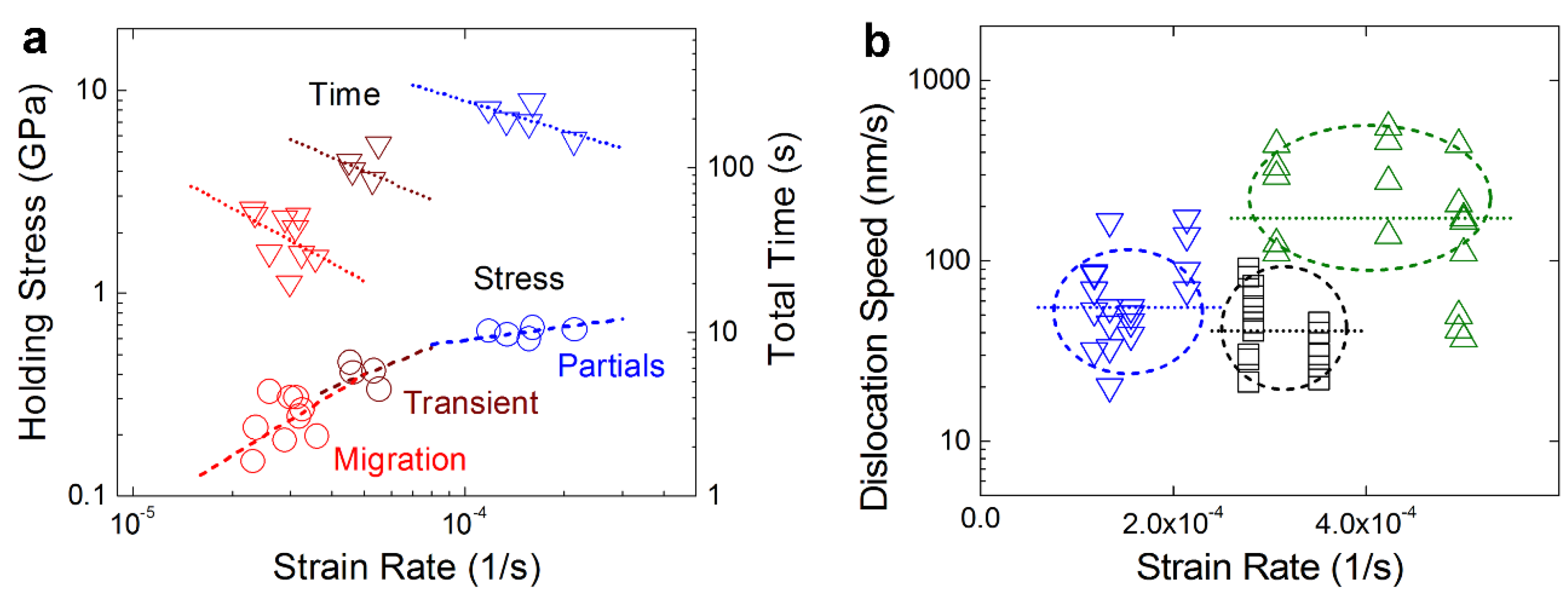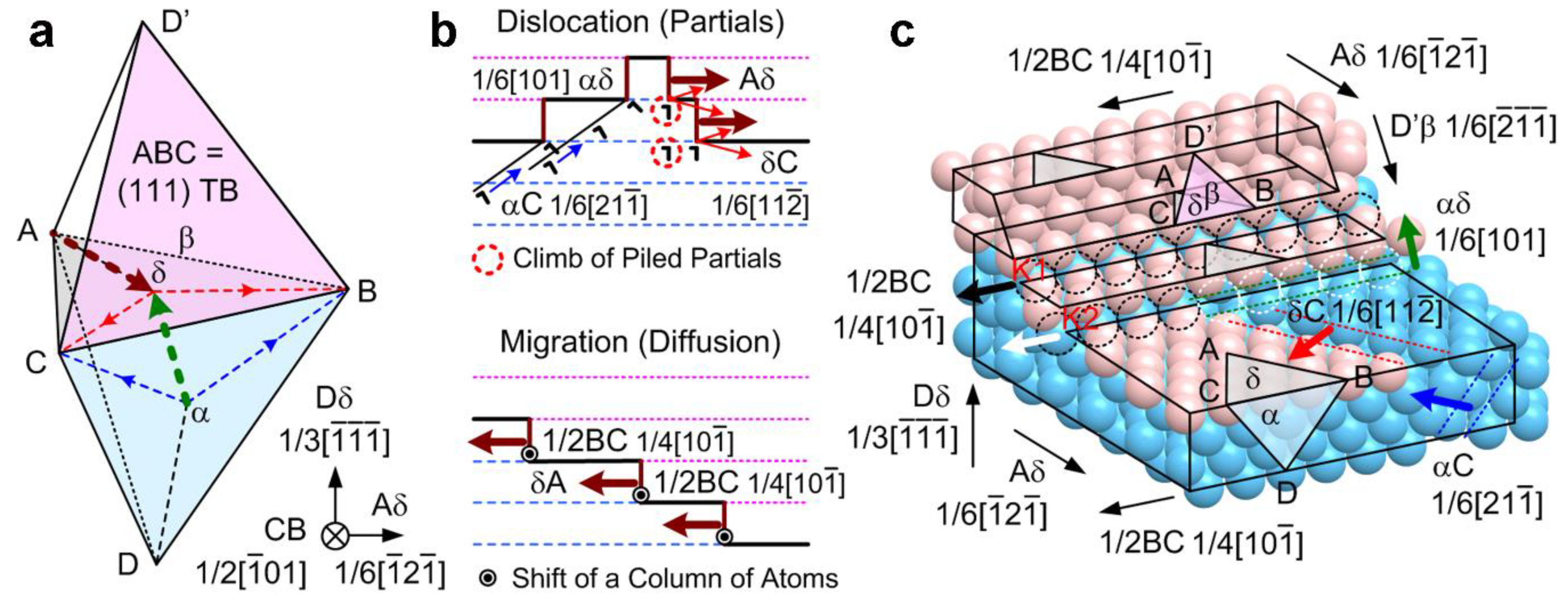In Situ Study of Twin Boundary Stability in Nanotwinned Copper Pillars under Different Strain Rates
Abstract
1. Introduction
2. Materials and Methods
3. Results and Discussion
3.1. Stress–Strain Responses of Cu Nanopillars
3.2. Deformation Behavior at Relatively High Strain Rates
3.3. Deformation Behavior at Medium to Low Strain Rates
3.4. Detwinning Mechanisms at Different Strain Rates
3.5. Detwinning by Kink-like Motion of Atoms
4. Concluding Remarks
Supplementary Materials
Author Contributions
Funding
Institutional Review Board Statement
Informed Consent Statement
Data Availability Statement
Acknowledgments
Conflicts of Interest
References
- Rosenberg, R.; Edelstein, D.C.; Hu, C.-K.; Rodbell, K.P. Copper metallization for high performance silicon technology. Annu. Rev. Mater. Sci. 2000, 30, 229–262. [Google Scholar] [CrossRef]
- Zhao, J.H. Electromigration and Electronic Device Degradation; John Wiley & Sons: New York, NY, USA, 1994; p. 171. [Google Scholar]
- Zhu, T.; Li, J. Ultra-strength materials. Prog. Mater. Sci. 2010, 55, 710–757. [Google Scholar] [CrossRef]
- Greer, J.R.; De Hosson, J.T.M. Plasticity in small-sized metallic systems: Intrinsic versus extrinsic size effect. Prog. Mater. Sci. 2011, 56, 654–724. [Google Scholar] [CrossRef]
- Chen, K.C.; Wu, W.W.; Liao, C.N.; Chen, L.J.; Tu, K.N. Observation of atomic diffusion at twin-modified grain boundaries in copper. Science 2008, 321, 1066–1069. [Google Scholar] [CrossRef] [PubMed]
- Lu, L.; Shen, Y.; Chen, X.; Qian, L.; Lu, K. Ultrahigh strength and high electrical conductivity in copper. Science 2004, 304, 422–426. [Google Scholar] [CrossRef]
- Dao, M.; Lu, L.; Shen, Y.F.; Suresh, S. Strength, strain-rate sensitivity and ductility of copper with nanoscale twins. Acta Mater. 2004, 54, 5421–5432. [Google Scholar] [CrossRef]
- Lu, L.; Chen, X.; Huang, X.; Lu, K. Revealing the maximum strength in nanotwinned copper. Science 2009, 323, 607–610. [Google Scholar] [CrossRef]
- Lu, K.; Lu, L.; Suresh, S. Strengthening materials by engineering coherent internal boundaries at the nanoscale. Science 2009, 324, 349–352. [Google Scholar] [CrossRef]
- Jang, D.; Li, X.; Gao, H.; Greer, J.R. Deformation mechanisms in nanotwinned metal nanopillars. Nat. Nanotechnol. 2012, 7, 594–601. [Google Scholar] [CrossRef]
- Zhu, L.; Ruan, H.; Li, X.; Dao, M.; Gao, H.; Lu, J. Modeling grain size dependent optimal twin spacing for achieving ultimate high strength and related high ductility in nanotwinned metals. Acta Mater. 2011, 59, 5544–5557. [Google Scholar] [CrossRef]
- Li, N.; Wang, J.; Misra, A.; Zhang, X.; Huang, J.Y.; Hirth, J.P. Twinning dislocation multiplication at a coherent twin boundary. Acta Mater. 2011, 59, 5989–5996. [Google Scholar] [CrossRef]
- Wu, Z.X.; Zhang, Y.W.; Srolovitz, D.J. Deformation mechanisms, length scales and optimizing the mechanical properties of nanotwinned metals. Acta Mater. 2011, 59, 6890–6900. [Google Scholar] [CrossRef]
- Ni, S.; Wang, Y.B.; Liao, X.Z.; Figueiredo, R.B.; Li, H.Q.; Ringer, S.P.; Langdon, T.G.; Zhu, Y.T. The effect of dislocation density on the interactions between dislocations and twin boundaries in nanocrystalline materials. Acta Mater. 2012, 60, 3181–3189. [Google Scholar] [CrossRef]
- You, Z.; Li, X.; Gui, L.; Lu, Q.; Zhu, T.; Gao, H.; Lu, L. Plastic anisotropy and associated deformation mechanisms in nanotwinned metals. Acta Mater. 2013, 61, 217–227. [Google Scholar] [CrossRef]
- Li, X.; Wei, Y.; Lu, L.; Lu, K.; Gao, H. Dislocation nucleation governed softening and maximum strength in nano-twinned metals. Nature 2010, 464, 877–880. [Google Scholar] [CrossRef]
- Wang, Y.M.; Sansoz, F.; LaGrange, T.; Ott, R.T.; Marian, J.; Barbee Jr, T.W.; Hamza, A.V. Defective twin boundaries in nanotwinned metals. Nat. Mater. 2013, 12, 697–702. [Google Scholar]
- Xu, L.; Xu, D.; Tu, K.N.; Cai, Y.; Wang, N.; Dixit, P.; Pang, J.H.L.; Miao, J. Structure and migration of (112) step on (111) twin boundaries in nanocrystalline copper. J. Appl. Phys. 2008, 104, 113717. [Google Scholar] [CrossRef]
- Brown, J.A.; Ghoniem, N.M. Structure and motion of junctions between coherent and incoherent twin boundaries in copper. Acta Mater. 2009, 57, 4454–4462. [Google Scholar] [CrossRef]
- Hsiao, H.Y.; Liu, C.M.; Lin, H.W.; Liu, T.C.; Lu, C.L.; Huang, Y.S.; Chen, C.; Tu, K.N. Unidirectional growth of microbumps on (111)-oriented and nanotwinned copper. Science 2012, 336, 1007–1010. [Google Scholar] [CrossRef]
- Chang, S.Y.; Chang, T.K. Grain size effect on nanomechanical properties and deformation behavior of copper under instrumented nanoindentation. J. Appl. Phys. 2007, 101, 033507. [Google Scholar] [CrossRef]
- Greer, J.R.; Oliver, W.C.; Nix, W.D. Size dependence of mechanical properties of gold at the micron scale in the absence of strain gradients. Acta Mater. 2005, 53, 1821–1830. [Google Scholar] [CrossRef]
- Greer, J.R.; Nix, W.D. Nanoscale gold pillars strengthened through dislocation starvation. Phys. Rev. B 2006, 73, 245410. [Google Scholar] [CrossRef]
- Je’rusalem, A.; Ferna’ndez, A.; Kunzb, A.; Greer, J.R. Continuum modeling of dislocation starvation and subsequent nucleation in nano-pillar compression. Scr. Mater. 2012, 66, 93–96. [Google Scholar] [CrossRef]
- Courtney, T.H. Mechanical Behavior of Materials, 2nd ed.; McGraw Hill: New York, NY, USA, 2000; pp. 44–61, 85–243, 293–353. [Google Scholar]
- Zhu, Y.T.; Wu, X.L.; Liao, X.Z.; Narayan, J.; Kecske’s, L.J.; Mathaudhu, S.N. Dislocation–twin interactions in nanocrystalline fcc metals. Acta Mater. 2011, 59, 812–821. [Google Scholar] [CrossRef]
- Zhu, Y.T.; Liao, X.Z.; Wu, X.L. Deformation twinning in nanocrystalline materials. Prog. Mater. Sci. 2012, 57, 1–62. [Google Scholar] [CrossRef]
- Caillard, D.; Martin, J.L. Thermally Activated Mechanisms in Crystal Plasticity; Elsevier: Amsterdam, The Netherlands, 2003; pp. 13–39. [Google Scholar]
- Wang, Z.J.; Li, Q.J.; Li, Y.; Huang, L.C.; Lu, L.; Dao, M.; Li, J.; Ma, E.; Suresh, S.; Shan, Z.W. Sliding of coherent twin boundaries. Nat. Comm. 2017, 8, 1108. [Google Scholar] [CrossRef]
- Gu, P.; Dao, M.; Suresh, S. Analysis of size-dependent slip transfer and inter-twin flow stress in a nanotwinned fcc metal. Acta Mater. 2014, 67, 409–417. [Google Scholar] [CrossRef]
- Chokshi, A.H.; Rosen, A.; Karch, J.; Gleiter, H. On the validity of the hall-petch relation in nanocrystalline materials. Scr. Metall. 1989, 23, 1679–1683. [Google Scholar] [CrossRef]
- Schiøtz, J.; Jacobsen, K.W. A maximum in the strength of nanocrystalline copper. Science 2003, 301, 1357–1359. [Google Scholar] [CrossRef]
- Shen, Y.F.; Lu, L.; Dao, M.; Suresh, S. Strain rate sensitivity of Cu with nanoscale twins. Scr. Mater. 2006, 55, 319–322. [Google Scholar]
- Wang, J.; Li, N.; Anderoglu, O.; Zhang, X.; Misra, A.; Huang, J.Y.; Hirth, J.P. Detwinning mechanisms for growth twins in face-centered cubic metals. Acta Mater. 2010, 58, 2262–2270. [Google Scholar] [CrossRef]
- Li, J.; Sarkar, S.; Cox, W.T.; Lenosky, T.J.; Bitzek, E.; Wang, Y. Diffusive molecular dynamics and its application to nanoindentation and sintering. Phys. Rev. B 2012, 84, 054103. [Google Scholar] [CrossRef]
- Sarkar, S.; Li, J.; Cox, W.T.; Bitzek, E.; Lenosky, T.J.; Wang, Y. Finding activation pathway of coupled displacive-diffusional defect processes in atomistics: Dislocation climb in fcc copper. Phys. Rev. B 2012, 86, 014115. [Google Scholar] [CrossRef]
- Sun, J.; He, L.; Lo, Y.C.; Xu, T.; Bi, H.; Sun, L.; Zhang, Z.; Mao, S.X.; Li, J. Liquid-like pseudoelasticity of sub-10-nm crystalline silver particles. Nat. Mater. 2017, 13, 1007–1012. [Google Scholar] [CrossRef] [PubMed]
- Zhong, L.; Sansoz, F.; He, Y.; Wang, C.; Zhang, Z.; Mao, S.X. Slip-activated surface creep with room-temperature super-elongation in metallic nanocrystals. Nat. Mater. 2017, 16, 439–446. [Google Scholar] [CrossRef]








Disclaimer/Publisher’s Note: The statements, opinions and data contained in all publications are solely those of the individual author(s) and contributor(s) and not of MDPI and/or the editor(s). MDPI and/or the editor(s) disclaim responsibility for any injury to people or property resulting from any ideas, methods, instructions or products referred to in the content. |
© 2023 by the authors. Licensee MDPI, Basel, Switzerland. This article is an open access article distributed under the terms and conditions of the Creative Commons Attribution (CC BY) license (https://creativecommons.org/licenses/by/4.0/).
Share and Cite
Chang, S.-Y.; Huang, Y.-C.; Lin, S.-Y.; Lu, C.-L.; Chen, C.; Dao, M. In Situ Study of Twin Boundary Stability in Nanotwinned Copper Pillars under Different Strain Rates. Nanomaterials 2023, 13, 190. https://doi.org/10.3390/nano13010190
Chang S-Y, Huang Y-C, Lin S-Y, Lu C-L, Chen C, Dao M. In Situ Study of Twin Boundary Stability in Nanotwinned Copper Pillars under Different Strain Rates. Nanomaterials. 2023; 13(1):190. https://doi.org/10.3390/nano13010190
Chicago/Turabian StyleChang, Shou-Yi, Yi-Chung Huang, Shao-Yi Lin, Chia-Ling Lu, Chih Chen, and Ming Dao. 2023. "In Situ Study of Twin Boundary Stability in Nanotwinned Copper Pillars under Different Strain Rates" Nanomaterials 13, no. 1: 190. https://doi.org/10.3390/nano13010190
APA StyleChang, S.-Y., Huang, Y.-C., Lin, S.-Y., Lu, C.-L., Chen, C., & Dao, M. (2023). In Situ Study of Twin Boundary Stability in Nanotwinned Copper Pillars under Different Strain Rates. Nanomaterials, 13(1), 190. https://doi.org/10.3390/nano13010190







